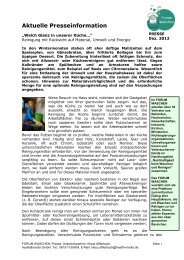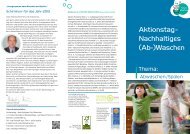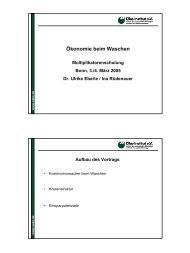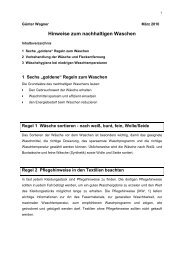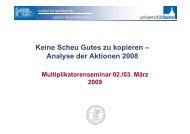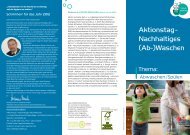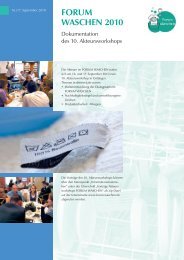Dishwasher penetration versus number of ... - Forum Waschen
Dishwasher penetration versus number of ... - Forum Waschen
Dishwasher penetration versus number of ... - Forum Waschen
Create successful ePaper yourself
Turn your PDF publications into a flip-book with our unique Google optimized e-Paper software.
DETERGENTS<br />
DISHWASHING<br />
R. Stamminger, C. Streichardt*<br />
Selected Aspects <strong>of</strong> Consumer Behaviour in<br />
the Manual and Mechanical Dishwashing<br />
in Germany<br />
� Methods<br />
Overall, 2599 completed questionnaires<br />
were analysed as being returned to the<br />
University <strong>of</strong> Bonn, Section Household<br />
and Appliance Technology for the census<br />
about the dishwasher consumer behaviours.<br />
They were collected by various<br />
stakeholders during public actions in the<br />
contexts <strong>of</strong> the Germany wide action day<br />
for ‘Sustainable Washing’ in 2006 (4).<br />
The questionnaire was split up into two<br />
subject areas. While the initially questions<br />
were on demographics, such as age,<br />
sex and household size in order to determine<br />
a possible connection or influence<br />
on the issue (dishwashing). The sec-<br />
Fig. 1 Age distribution <strong>of</strong> participants (n=2599)<br />
Introduction<br />
This article intends to shed some light to the consumer behaviour in the manual and automatic dishwashing<br />
area. Recently published articles have highlighted quite significant differences in the way manual dishwashing<br />
is done in Europe (1), based on tests done in a laboratory atmosphere. Another article has summarised published<br />
data on the historical development <strong>of</strong> resource use and costs for manual and automatic dishwashing in Germany<br />
(2), but is based mainly on results gathered for a complete load <strong>of</strong> dishes washed. Another article has shown<br />
that washing-up <strong>of</strong> smaller loads will tentatively increase the use <strong>of</strong> water, energy and cleanser by the consumer<br />
(3). All these tests and comparisons are based on relative small <strong>number</strong>s <strong>of</strong> people observed.<br />
In the context <strong>of</strong> sustainable consumption it is <strong>of</strong> interest to learn more about the actual consumer behaviour <strong>of</strong><br />
washing up <strong>of</strong> dishes. In this context following question are interesting:<br />
• How much dishes need to be washed?<br />
• Which dishwashing practices dominate in the German households?<br />
• Which cleaning products are adopted if a dishwasher is available or not?<br />
• How satisfied are the people with the cleaning and drying result <strong>of</strong> a dishwasher and are there correlations to<br />
their behaviour?<br />
50 SOFW-Journal | 135 | 11-2009
DETERGENTS<br />
DISHWASHING<br />
ond subject area adverts to the manual<br />
and mechanical dishwashing.<br />
Focus on data collection ranged from<br />
frequency and way <strong>of</strong> washing up by hand<br />
or using a dishwasher over the dishes<br />
needed to be washed up to the satisfaction<br />
with the results achieved. Additionally<br />
the use <strong>of</strong> cleansers and other chemical<br />
components was investigated.<br />
� Results<br />
The sample consists <strong>of</strong> 2599 people, where<br />
79% <strong>of</strong> them quoted as female and 11%<br />
as male. 10% <strong>of</strong> the questioned people<br />
didn’t answer the question on gender at<br />
all.<br />
The age distribution (Fig. 1) depicts are<br />
high <strong>number</strong> <strong>of</strong> older people (above 45<br />
years) and some youngsters.<br />
The household size is between 1-person<br />
to 6-person households, while two-person<br />
households define the majority <strong>of</strong><br />
the sample (Fig. 2). This reflects the way<br />
the questionnaires were collected and no<br />
representativeness can be assigned to<br />
the results. Nevertheless they reflect<br />
some interesting learning, especially when<br />
normalised data can be extracted.<br />
Following, the questionnaire is split into<br />
two groups <strong>of</strong> households: Households<br />
with a dishwasher (with DW) and households<br />
without a dishwasher (without DW).<br />
64% <strong>of</strong> the people answering the questionnaire<br />
possess a dishwasher which<br />
corresponds very well to the <strong>of</strong>ficial<br />
<strong>penetration</strong> <strong>of</strong> dishwashers in Germany<br />
(65% in the year 2005 (5)). A deeper look<br />
into the data shows that multi-person<br />
households tend to have higher <strong>penetration</strong><br />
<strong>of</strong> dishwashers the more person<br />
are living in the household, while only<br />
32% <strong>of</strong> the single households own a<br />
dishwasher (Fig. 3).<br />
Regarding the frequency <strong>of</strong> manual<br />
dishwashing it is somehow surprising to<br />
see, that for households not owning a<br />
dishwasher this happens for 9,9 times<br />
while household with dishwashers still<br />
record a frequency <strong>of</strong> 7,2 manual washing<br />
cycles per week. This comparison is<br />
influences by the different household<br />
sizes. Therefore it is more relevant to<br />
compare this on an equal household size<br />
basis. Selecting only 2-person households<br />
still 6,8 manual dishwashing processes<br />
Fig. 2 Distribution <strong>of</strong> the size <strong>of</strong> household<br />
Fig. 3 <strong>Dishwasher</strong> <strong>penetration</strong> <strong>versus</strong> <strong>number</strong> <strong>of</strong> persons in household<br />
Fig. 4 Number <strong>of</strong> items washed per day<br />
52 SOFW-Journal | 135 | 11-2009
DETERGENTS<br />
DISHWASHING<br />
are done in households owning a dishwasher,<br />
while household without dishwasher<br />
run 10,1 washing cycles per week.<br />
The <strong>number</strong> <strong>of</strong> items washed per day<br />
depends primary on the household size<br />
(Fig. 4), but secondary also on the availability<br />
<strong>of</strong> a dishwasher. This may be due<br />
to a more flexible use <strong>of</strong> items when they<br />
are not to be washed manually afterwards,<br />
but it may be also just caused by<br />
the opposite: households having more<br />
items to be washed (e.g. as they are at<br />
home all time) may tend to have more<br />
likely a dishwasher!<br />
Concentrating again on 2-person households<br />
owning a dishwasher the type <strong>of</strong><br />
items washed are mainly cutlery, plates,<br />
cups and glasses (Fig. 5). Pots and pans<br />
and wooden items are more frequently<br />
washed up by hand as in a dishwasher.<br />
Regarding the way dishes are washed<br />
51% quote to wash the dishes mainly in<br />
a sink while 7,7% commit to do it under<br />
running tap water. While this practices<br />
show no difference between mal and female<br />
persons, there show up some differences<br />
between owners and not owners<br />
<strong>of</strong> dishwashers (Fig. 6): households<br />
owning a dishwasher are more likely to<br />
use the running tap water for doing their<br />
dish work. This may be correlated to the<br />
<strong>number</strong> <strong>of</strong> items to be washed, but no<br />
prove <strong>of</strong> this hypothesis is possible using<br />
the data collected.<br />
Looking on the households owning a<br />
dishwasher, its use is highly depending<br />
on the <strong>number</strong> <strong>of</strong> persons living in the<br />
household (Fig. 7). In average it is operated<br />
for 1,6 cycles per week per person<br />
living in the household or 4,2 cycles per<br />
household per week. Many <strong>of</strong> the items<br />
loaded into a dishwasher are subject <strong>of</strong><br />
some pre-treatment (Fig. 8). Wiping <strong>of</strong>f<br />
the residues does not use much additional<br />
resources, but soaking and prerinsing<br />
use at least some water and perhaps<br />
energy and cleanser. This needs to<br />
be considered as an additional consumption<br />
for automatic dishwashing (6).<br />
Consumptions are also mainly depending<br />
on the age <strong>of</strong> the dishwasher (2) and<br />
on the program selected. Average age <strong>of</strong><br />
dishwasher used in those households<br />
owning a dishwasher was reported to be<br />
6,0 years. The programs selected (Table 1)<br />
were estimated on the response on the<br />
question about which program was se-<br />
Fig. 5 Type and <strong>number</strong> <strong>of</strong> items washed in average in a 2-person household owning<br />
a dishwasher per day<br />
Fig. 6 Manual dishwashing practice<br />
Fig. 7 Pre-treatment <strong>of</strong> items before loading in a dishwasher<br />
(multiple answers allowed)<br />
54 SOFW-Journal | 135 | 11-2009
Program type Usage in %<br />
Intensive 8.9<br />
Normal 60-65° 29.1<br />
Normal 50-55°C 27.7<br />
Eco- or saving program 17.7<br />
Quick program 8.7<br />
Autoatic program 7.8<br />
Pre-rinse 6.0<br />
Table 1 Estimated program selection<br />
lected always, <strong>of</strong>ten, sometimes, seldom<br />
and never and transferring this into digital<br />
values by assigning 100%, 75%, 50%,<br />
25% and 0% to each <strong>of</strong> these categories.<br />
Fig. 8 Satisfaction with cleaning and drying performance<br />
Fig. 9 Insufficient cleaning and drying results reported<br />
(multiple answers allowed)<br />
But it has to be kept in mind that programs<br />
may be named differently on machines<br />
or may be not present at all.<br />
Regarding the use <strong>of</strong> cleansers and additives<br />
in automatic dishwashing, the survey<br />
shows that a majority <strong>of</strong> people use<br />
tablets (76,2%), especially multifunctional<br />
tablets (64,7%). Somehow surprising,<br />
60,7% <strong>of</strong> all consumers do also use rinseaid<br />
in their dishwashers and even 49,7%<br />
<strong>of</strong> those using multi-functional tablets<br />
also claim to use rinse-aid.<br />
Asked also about the satisfaction or dissatisfaction<br />
with the performance delivered<br />
by their dishwasher consumer reported<br />
a very high level <strong>of</strong> satisfaction.<br />
DETERGENTS<br />
DISHWASHING<br />
Auf den Punkt<br />
gebracht<br />
Die Mediainformationen 2010.<br />
Anzeigenpreise, Redaktionsund<br />
Terminpläne 2010,<br />
Auflagen-Analysen.<br />
Alles auf den Punkt gebracht.<br />
Mediaservice:<br />
Siegfried Fischer<br />
Tel.: +49 821 32583-16<br />
Fax: +49 821 32583-23<br />
E-Mail: s.fischer@s<strong>of</strong>w.com<br />
Die Mediainformationen stehen<br />
auch zum Download bereit auf<br />
www.s<strong>of</strong>w.com<br />
(→ SOFW-Journal → Mediadaten)<br />
www.s<strong>of</strong>w.com<br />
SOFW-Journal | 135 | 11-2009 55
DETERGENTS<br />
DISHWASHING<br />
The percentage <strong>of</strong> consumers not satisfied<br />
with the performance is well below<br />
5%. Surprisingly, there is no significant<br />
difference in the result, when comparing<br />
the usage <strong>of</strong> powder or tablets or the use<br />
<strong>of</strong> additional rinse-aid to multifunctional<br />
products.<br />
Asked about the items where insufficiencies<br />
<strong>of</strong> cleaning and drying are observed<br />
there are many more replies then<br />
on the previous question about the general<br />
satisfaction (Fig. 9). While cleaning<br />
is reported to be insufficient mainly on<br />
cutlery, pots and pans drying is reported<br />
to be insufficient mainly on glasses and<br />
plastic items.<br />
� Conclusion<br />
With this study a first clear inside into<br />
dishwashing practice in German households<br />
is done. Not surprising, the replies<br />
recorded do not answer all questions, but<br />
raise even more:<br />
Why do people show different manual<br />
washing-up practice when owning<br />
a dishwasher?<br />
How much additional energy and water<br />
is used for pre-treatment <strong>of</strong> items<br />
before putting them into a dishwasher?<br />
How much do cleanser and/or the<br />
machine influence the satisfaction<br />
with the result?<br />
These questions may need to have a closer<br />
look to the real life behaviour and it<br />
may not possible to be answered just by<br />
asking consumer to fill a questionnaire.<br />
Anyhow, it must be kept in mind that answering<br />
a questionnaire may not reflect<br />
the absolute truth. So care must be taken<br />
in interpreting all data reported.<br />
References<br />
(1) Stamminger R., Elschenbroich A., Rummler B.,<br />
Broil G. (2007). Washing-up Behaviour and<br />
Techniques in Europe. Hauswirtschaft und Wissenschaft<br />
1, p. 31-40 and references there in<br />
(2) Stamminger R. (2006). Daten und Fakten zum<br />
Geschirrspülen. SOFW-Journal 132, p. 72- 81<br />
(3) Stamminger R., Rummler B., Elschenbroich A.,<br />
Broil G. (2007). Dishwashing Under Various<br />
Consumer-relevant Conditions. Hauswirtschaft<br />
und Wissenschaft 2, p.81-88<br />
(4) Stamminger R., Goerdeler G. (2005). <strong>Waschen</strong><br />
in Deutschland – Auswertung einer Verbraucherbefragung.<br />
SOFW-Journal 131, p. 59-68<br />
(5) Presutto, M. (2007). Preparatory Studies for<br />
Eco-design Requirements <strong>of</strong> EuPs (Tender<br />
TREN/D1/40-2005). Lot 13, Lot 14. A Portrait <strong>of</strong><br />
the Household Appliance Industry and Market<br />
in Europe. Retrieved April 22, 2009 from<br />
www.ecowet-domestic.org<br />
(6) Stamminger R. (2007). Preparatory Studies for<br />
Eco-design Requirements <strong>of</strong> EuPs (Tender<br />
TREN/D1/40-2005), Lot 14/ Task 3 Wash final.<br />
Retrieved April 22, 2009 from www.ecowetdomestic.org<br />
* Authors’ address:<br />
Pr<strong>of</strong>. Dr. Rainer Stamminger<br />
Claudia Streichardt<br />
Sektion Haushaltstechnik<br />
Universität Bonn<br />
Institut für Landtechnik<br />
Nussallee 5<br />
53115 Bonn<br />
Germany<br />
Email: stamminger@uni-bonn.de<br />
56 SOFW-Journal | 135 | 11-2009<br />
�




